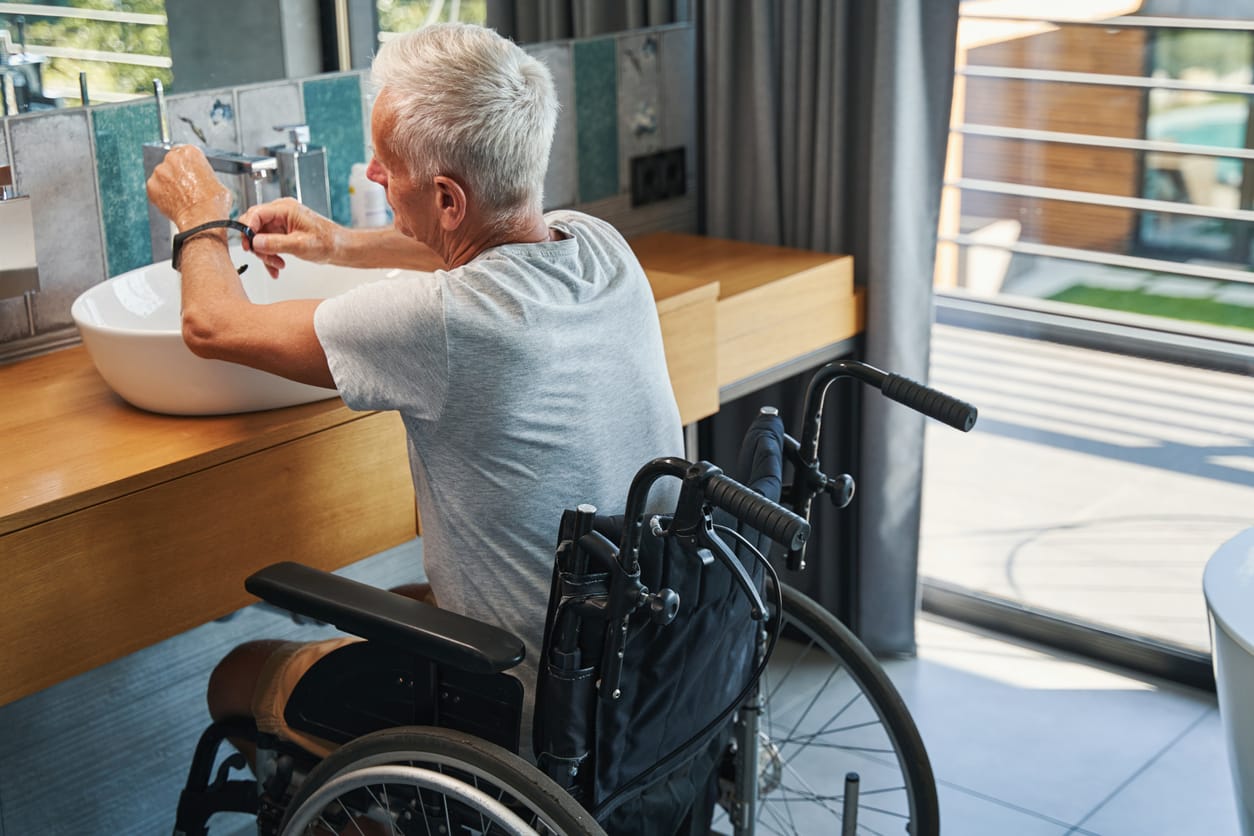In the ever-evolving landscape of technological innovation, wearable devices have emerged as transformative tools that seamlessly integrate into our daily lives. These gadgets, worn as accessories or clothing, have transcended mere novelties, becoming indispensable companions that bridge the gap between humans and technology.
These sophisticated devices are not just for the tech-savvy younger generation; they hold immense potential to address the unique health and safety needs of seniors. Wearable tech has transcended its initial boundaries, extending its benefits to enhance the overall well-being of the elderly.
Various Health and Safety Benefits of Wearable Technology
This exploration seeks to unravel the layers of wearable technology tailored for seniors, examining its potential to revolutionize health monitoring, enhance safety, and contribute to the cognitive well-being of the elderly. The thesis encapsulates the core mission: to shed light on the myriad ways in which wearable technology can be a transformative force, promoting the health and safety of the senior population.
The Different Types of Wearable Devices Available
The wearable technology market offers a plethora of devices tailored to diverse needs. Smartwatches, fitness trackers, and health monitors are just the tip of the iceberg. This section provides a comprehensive overview of the types of wearables available, setting the stage for a nuanced exploration of their applications for seniors.
Wearable Devices Designed for Health Tracking and Monitoring
Indeed, wearable devices designed for health tracking and monitoring have played a significant role in transforming the way individuals, especially seniors, manage and monitor their health. These devices leverage advanced sensors and technology to provide real-time data on various health metrics.
- Heart Rate Monitoring:
- Wearables use optical sensors to continuously monitor heart rate.
- Real-time data helps individuals understand their heart health and track changes over time.
- Activity Tracking:
- Accelerometers and gyroscope sensors measure movement and activity levels throughout the day.
- Users can set fitness goals and monitor their progress, promoting an active lifestyle.
- Sleep Analysis:
- Wearables equipped with sleep tracking features monitor sleep patterns, including duration and quality.
- Insights aid in improving sleep habits and addressing sleep-related issues.
- Caloric Burn and Exercise Recognition:
- Some wearables can estimate the number of calories burned during physical activities.
- Advanced models use machine learning to recognize specific exercises and provide more accurate data.
Wearable Technology that Enhances Safety for Seniors
Safety is a paramount concern for seniors, and wearable technology has risen to the challenge. This section delves into wearables designed to enhance safety, exploring features such as fall detection, emergency alert systems, and GPS tracking.
- Fall Detection:
- Wearables with built-in accelerometers and gyroscopes can detect sudden movements indicative of a fall.
- Automatic alerts can be sent to emergency contacts or healthcare providers if a fall is detected, ensuring swift assistance.
- Emergency Alert Systems:
- Some wearables are equipped with emergency buttons or features that allow seniors to call for help in case of an emergency.
- GPS technology can help emergency services locate the wearer quickly.
- GPS Tracking:
- Wearables with GPS tracking capabilities provide real-time location data, offering peace of mind to both seniors and their caregivers.
- This feature is particularly useful for those with dementia or Alzheimer's disease who may wander.
- SOS Features:
- Certain wearables have dedicated SOS buttons that, when pressed, initiate immediate communication with predefined emergency contacts.
Wearable Technology in Medication Management for Seniors
Medication adherence is a critical aspect of senior health. This section explores how wearable technology is seamlessly integrated into medication management, offering solutions that include medication reminders and dosage tracking.
- Medication Reminders:
- Wearables can be programmed to deliver medication reminders through vibrations, notifications, or alarms.
- This helps seniors stay on schedule with their medications, promoting better health outcomes.
- Dosage Tracking:
- Some wearables allow users to log and track their medication dosage history.
- Caregivers or healthcare providers can remotely access this information for better medication management.
- Integration with Smart Pill Dispensers:
- Wearables can sync with smart pill dispensers, ensuring that the right medications are taken at the right time.
- Smart dispensers can also send alerts to both seniors and caregivers if a dosage is missed.
Wearables Designed to Support Cognitive Health in Seniors
Cognitive health is a vital component of overall well-being, particularly for seniors. This section introduces wearables specifically crafted to support cognitive health, offering features such as brain games, memory exercises, and cognitive assessments.
- Brain Games and Cognitive Exercises:
- Wearables may offer cognitive training programs, including brain games and exercises that stimulate mental activity.
- Regular engagement with these features can help maintain cognitive function and delay cognitive decline.
- Memory Tracking:
- Some wearables include features to track and assess memory performance over time.
- This data can be shared with healthcare professionals for a more comprehensive understanding of cognitive health.
- Cognitive Health Assessments:
- Wearables may provide periodic assessments to measure cognitive abilities and identify any potential issues.
- The results can be shared with healthcare providers for early intervention and personalized care.
- Voice-Activated Assistance:
- Wearables equipped with voice-activated assistants can assist seniors with daily tasks, providing reminders and answering questions to support cognitive function.
Common Barriers That May Prevent Seniors from Adopting Wearable Technology
We all want our senior loved ones to live healthy, independent lives. Today, wearable technology offers exciting possibilities, but navigating the digital waters can be tricky. As their biggest cheerleaders, we can play a crucial role in helping them overcome hurdles and embrace the benefits of wearable tech.
Understanding the "Why Not?":
- Fear Factor: Technology phobia is real! Be patient, offer gentle guidance, and celebrate small victories.
- Complexity Conundrum: Large screens, intuitive interfaces, and voice controls can ease the learning curve.
- Physical Limitations: Big buttons, adjustable straps, and voice commands make tech more accessible.
- Privacy Panic: Assure them of data security, explain data-sharing policies, and emphasize their control over information.
- Cost Crunch: Explore affordable options, insurance coverage, and even rental programs.
- Fashion Faux Pas: Stylish designs encourage adoption and combat age-related stigma.
- Relevance Riddle: Showcase real-life benefits like fall detection, medication reminders, and chronic disease management.
Becoming Their Tech Champions:
- Education is Key: Offer tutorials, hands-on training, and readily available support to build confidence.
- Personalization Matters: Help them customize features, set goals, and choose apps that match their needs and preferences.
- Motivation Matters: Highlight the potential benefits: improved health, increased independence, and enhanced safety.
- Support Squad Assemble: Encourage family and friends to be tech cheerleaders, offering help and celebrating progress.
Remember:
- Patience is a Virtue: Learning takes time. Celebrate small wins and encourage continued exploration.
- Focus on Benefits: Show them how wearables can bring real-life improvements to their health and well-being.
- It's Their Journey: Guide them, but let them lead. Their comfort and confidence are paramount.
Wrapping Up: A Future of Health and Independence
In conclusion, the ever-expanding realm of wearable technology has transcended its initial boundaries to become a transformative force in enhancing the health, safety, and cognitive well-being of the elderly. As explored in this comprehensive examination, wearables designed for seniors offer a myriad of health and safety benefits, ranging from advanced health monitoring to innovative safety features such as fall detection and GPS tracking. These devices seamlessly integrate into daily life, addressing the unique needs of the senior population and fostering a sense of independence.
However, it is essential to acknowledge and navigate the barriers that may impede seniors from adopting wearable technology. From technological complexity to concerns about privacy and security, understanding these challenges allows us to become advocates and champions for our senior loved ones in their journey to embrace these transformative tools. By providing patient guidance, personalized support, and emphasizing the tangible benefits of wearables, we can empower seniors to overcome hurdles, fostering a future where they not only embrace but thrive with the positive impact of wearable technology on their health and well-being.





